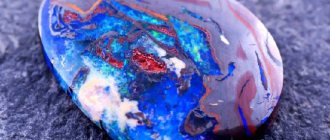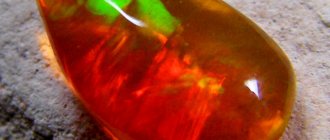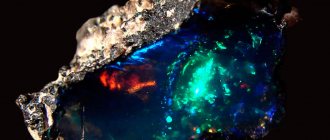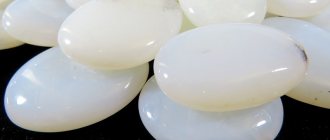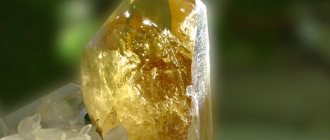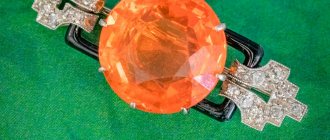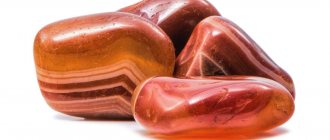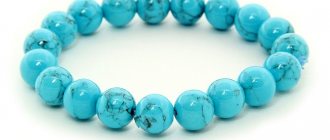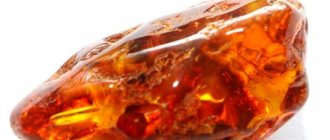Historical reference
Opal was known to ancient peoples; beautiful and frightening legends were created about it.
Opal is mentioned in myths and traditions on all continents.
- The ancient Greeks associated it with the victory of Zeus over the Titans, after which the supreme god burst into tears of happiness. The tears that fell to the ground became rainbow opals. It was believed that the Zeus stone made the owner a fortune teller.
- Australian aborigines are confident that sparkling stones, called “desert fire,” remained on the site of the traces of the Creator of the World.
- Arabic legends claim that opals are the children of lightning, brought to earth. The stone can protect from thunderstorms or bad weather, and make a person invisible.
- In India, opals are considered parts of the body of the rainbow goddess. Fleeing from annoying gentlemen, she fell, crumbling onto beautiful stones.
For centuries, opal's purpose has been to bring good luck. But the fall from grace is ambiguous. To the Romans it represented hope and purity, but black opal was Caligula's favorite. This friendship became fatal for the emperor. Scandinavian sagas say that the opal stone was forged by the blacksmith god from children's eyes. The early Middle Ages is full of descriptions of dark rituals with opal in the leading role. Opal powder was a poison that was added to food.
The English King Edward VII, in order to protect himself from the influence of the gem, ordered the opals to be removed from the crown. Napoleon's wife Josephine laughed at this - and in vain. When the Burning Troy pebble moved into their home, the couple divorced. Then they began to say that the mineral allegedly self-destructed, dissolving into the air. This is possible, given the properties of natural opal. Clients refused the stones, and jewelers had no choice but to throw them away.
History of opal
Opal is a legendarily beautiful stone.
At the same time, each nation composed its own legends and myths about it. The myths of Ancient Greece tell how Zeus, after defeating the Titans, cried with happiness, and when his tears fell to the ground, they turned into rainbow opals.
In Australia, the appearance of opals is associated with the fact that the one who created our world decided one day to descend and pass on knowledge to people, and his every step was imprinted in the form of rainbow stones.
— Advertising —
The people of India associate opals with the goddess of love. It is believed that the goddess fled from the men who were hunting her, fell and turned into beautiful stones.
Due to many such legends, opal is known as a famous mystical symbol and is widely used in jewelry and magic. The term "opal" comes from the word "stone" in Sanskrit and ancient Greek.
Origin
A fragment of the jaw of the ancient mammal Kollikodon ritchiei, which became opal during the process of fossilization. It
has been scientifically proven that opals are petrified trees and skeletons of small animals. They formed in the ground or craters of volcanoes.
Forms of opal release: cluster-shaped or kidney-shaped aggregates of amorphous silica, cracks. It usually occurs among limonites, sandstones, rhyolites and basalts.
The origin is sedimentary, supergene or low-temperature hydrothermal. It occurs in the form of veins, filling cracks in the host rocks.
The rocks diatomite, tripolite and opoka are made up of scattered small particles of opal.
Opal forms various kinds of sintered forms or nodules, often forms pseudomorphs on various minerals, and also impregnates various animal and plant remains, forming fossils. Sometimes found in the form of earthy masses or fine powder.
Description of the stone
Natural opal in the scientific sense is amorphous silica. It's not so much a rock as it is a hardened gel, cracked and tarnished over time.
Natural opal has a life cycle. It tends to age, but the process can be slowed down if you properly care for the stone.
Aged specimens are called chalcedony.
Although opal is not a precious stone, it has natural energy and some beneficial properties. Noble opal improves general condition, reveals talents and favors creative people.
The name of opal can be translated:
- from Latin as “bewitching sight”;
- “precious stone” - from Sanskrit;
- “to see changes” – from Greek.
Externally, the gem differs from others in its unusual opalescence effect. It looks like there is a small piece of the rainbow inside. The shade of the stone depends on its variety.
In addition to the topic, video review:
Types and colors of opal
The breed has over 140 varieties. They differ in the amount and type of impurities, location, and physical characteristics. The most common gems are called simple. Precious opals are considered more valuable and rare:
- fire - transparent opal of golden-orange color, the most famous are: Brazilian, with low water content, and Mexican, with an opalescence effect;
- royal - a red gem in the middle with greenish edges;
- lechos-opal is a light green mineral with dark green inclusions;
- cat's eye - a light mineral with a pearlescent tint;
- black is the most valuable representative of the family, sometimes found in dark green, inky tones;
- harlequin - a transparent gem with many colored inclusions;
- girazole is a colorless, transparent mineral with a bluish tint.
There are no less varieties of simple opals:
- boulder – an organic doublet (2 glued halves) made of ferruginous rocks with opal inclusions;
- hyalite is a colorless stone, similar in appearance to glass;
- waxy - a golden or amber gem that shimmers in the light;
- chrysopal is a mineral that has a green color;
- honey – translucent yellow mineral;
- rainbow Ethiopian - a gem with a varied color palette, externally appearing more voluminous;
- mossy – opal with a grassy green color;
- Peruvian blue - a turquoise mineral with a pinkish tint and an iridescent internal glow;
- cacholong – snow-white opal with a pearl tint;
- dark – gray, smoky gem with a matte sheen;
- woody - a mineral with a bizarre pattern, formed during the replacement of rotted bark with opal;
- aqueous – a cloudy, colorless stone that can absorb water and become more transparent;
- dendritic - milky in color with inclusions in the form of twigs, mosses, and plants.
In addition to ornamental varieties, there is a separate type of opal rock that is used in industry.
For example, opal-cristobalite rock is actively used in construction. Cristobalites are considered a good sorption material, they are strong and durable.
Physical and chemical properties
Opal is amorphous silica, devoid of a crystal lattice. Semi-precious jewelry stone.
The color of opal varies, but all types have a common characteristic: pearlescent luster. The effect in which the glow comes from inside the stone and scatters across the surface is named after the stone - opalescence. Applies to other precious minerals.
Opals can be transparent or translucent. This determines the percentage of water in the stone: the more, the more transparent the gem. For the noble ones - strictly 6-10%.
| Color | Colorless, white, yellow, red, brown, blue |
| Stroke color | white |
| origin of name | from the ancient Indian upala - precious stone |
| Opening year | known since ancient times |
| IMA status | valid, first described before 1959 (before IMA) |
| Chemical formula | SiO2+H2O |
| Shine | glassy, greasy, waxy, pearlescent, dull |
| Transparency | transparent, translucent, opaque |
| Cleavage | not visible |
| Kink | conchoidal, uneven |
| Hardness | 5,5, 6, 6,5 |
| Thermal properties | Under the blowpipe it cracks a lot, but does not melt. |
| Luminescence | yellow-green (uranyl) |
| Strunz (8th edition) | 4/D.01-80 |
| Hey's CIM Ref. | 7.8.8 |
| Dana (8th edition) | 75.2.1.1 |
| Molecular weight | 87.11 |
| Density (measured) | 1.9 — 2.3 |
| Pleochroism | does not pleochroate |
| Refractive indices | nα = 1.400 – 1.460 |
| Optical relief | moderate |
| Selection form | kidney-shaped, collomorphic cluster-shaped, stalactite sinter aggregates, plaques, concretions, geodes, solid masses, pseudomorphs of organic remains and some minerals |
| Classes on taxonomy of the USSR | Oxides |
| IMA classes | Oxides |
| singonia | amorphous |
| Fragility | Yes |
Physicochemical characteristics of opal
Opals may contain various impurities.
For example, in the presence of iron, the so-called “opal jasper” is formed. But all types of stone have similar characteristics. Opal has a pronounced pearlescent luster; it is either dim or shines like glass. The degree of transparency can vary: from slightly translucent to completely transparent. The surface of white specimens differs in shades of blue, yellow, and pink; for black opals, it shimmers with all the colors of the rainbow; for fiery opals, it shimmers with brown or green tones. Opals have no cleavage; they are fragile. Hardness on the Mohs scale is 5.5-6.5. The fracture is fragile. Opal is destroyed by the action of alkalis.
Colors and varieties
Depending on the properties: color, shine, transparency, hardness, impurities, a fairly significant number of varieties of opals are distinguished.
Opals formed from the silica of weathering silicate rocks, filling cracks and voids in them or penetrating into their mass, are “impure.” These include:
- semi-opal, cloudy, with a greasy sheen, white, gray, yellow, red and brown;
- opal jasper, which is colored red or brown with an admixture of a significant amount of iron oxides.
Opal Jasper
- Wood opal – formed when opal replaces wood residues, preserving the texture of wood (petrified wood).
Wood opal
- Siliceous tuff is a porous, spongy rock formed from hot springs.
Siliceous tuff
- Tripoli (polishing slate) are earthy, loose deposits of microscopic organisms, mainly diatoms.
Trepel
- Noble opal is distinguished by a beautiful play of colors. The color is mostly milky white or yellowish, blue and even black. Translucent or translucent. Refers to precious stones.
Precious opal
- Ordinary opal does not have a play of colors. Transparency to varying degrees. Sometimes colorless, but mostly painted in various dim colors. Beautiful specimens are polished and considered semi-precious stones.
Common opal Other types of opals:
- Fire Opal - Translucent to translucent stones, mostly with colors ranging from hyacinth red to wine yellow, almost red, often without any play. Variations with opalescence are mined in Mexico.
Fire opal
- Black opal is an opal with a dark, not necessarily black, base color, the most expensive variety of precious opals (in particular, Australian black opals).
Black opal
- Boulder (English boulder - cobblestone, boulder) is a type of opal in the form of a layer in the rock, most often ferruginous, but there are also matrix boulders in rhyolite and basalt rocks. The best varieties of boulders, jowa and koroite, are mined in Australia.
Boulder opal
- Wax opal is waxy yellow in color.
Wax opal
- Hyalite is water-transparent, forms grape-shaped crusts on various rocks; sometimes covered with mosses and lichens.
Opal Hyalite
- Hydrophane, water opal, is porous; when saturated with water, it becomes translucent and reveals a beautiful play of colors.
Hydrophane water opal
- Girazol (girasol, girasol) is transparent, almost colorless, with an iridescent bluish tint, usually on a pale milky background.
Opal Girasol
- Irisopal is colorless or slightly brownish with a single-color tint, mined in Mexico.
Irisopal
- Cacholong, pearl opal, semi-opal is a milky white stone that is an opaque mixture of quartz, chalcedony and porcelain opal.
Cacholong
- Peruvian (blue) opal - pink, blue and even bluish stones are found in Peru. They are not multi-colored.
Blue Peruvian opal
- Prazopal, chrysopal is an opaque apple-green stone.
Chrysopal
Why and how is opal colored?
As silica precipitated in solution and the water content of the gel gradually decreased, spheres formed. The spheres are formed by silica particles that spontaneously adhere to other particles that form around it. These spheres of amorphous silica range in size from 1500 to 3500 angstroms (1 angstrom is 1 ten millionths of 1 millimeter).
The formation areas are not only remarkably uniform in size, but are also packed in a very regular array. Because they are spherical, tiny holes are left in the structure (almost the same as when placing balls in a container), and these holes are also arranged in a three-dimensional pattern. Therefore, due to the regular array of these cavities, opal provides an optical diffraction grating for visible light.
When the spheres are larger (about 3500 angstroms in diameter), red or orange colors are created. And at the other end of the scale, at a diameter of about 1500 angstroms, the blue end of the spectrum is diffracted. Between these figures are the rest of the colors of the rainbow. From this we can conclude that the diffraction of light in voids is greatest when the size of the sphere is larger. Therefore, red is usually the brightest color and blue is the dullest color.
Thus, the color in fine opal is caused by a regular array of silica spheres and voids diffracting white light and breaking them up into the colors of the spectrum (rainbow). The diameter and distance of the balls control the color range of the opal. Small spheres produce only blue opal (the most common color), while larger spheres produce red opal (the rarest color).
Place of Birth
Opal
Opal is often found in thin layers or flat lenses, large pieces are rare. It is found on all continents, but Australian deposits account for, according to some statements, about 97% of all world production. Of these, 90% are called “light opals” or white crystalline opals.
Most Australian opals are mined in Coober Pedy in South Australia. The boulder type is mined in the state of Queensland. One of the largest mines producing this type of mining is Jundah. In the state of New South Wales, in the area of the town of Lightning Ridge, another opal with a predominant black color is mined (with a play of colors from dark gray to black-blue). This type is considered the rarest, as black opal accounts for only about 5% of the total opal mined in Australia. Opal is considered the national stone of Australia.
In addition to Australia, Ethiopia is a major exporter of opals. Most of the precious opals are mined in Australia, Mexico, Brazil, Guatemala, Honduras, Japan, Slovakia, the USA (Nevada), with minor occurrences in Russia (Kamchatka) and Ukraine.
Ordinary and fire opals are often found in Mexico (states of Hidalgo (state) and Queretaro), Brazil, Guatemala, Honduras, USA, Turkey, Kazakhstan.
This is interesting!
In late 2008, NASA announced that it had discovered opals on Mars.
Large family of opals
Australian scientist F. Leekhman counted 134 varieties of opal.
Mineralogists try to classify opals based on transparency, color, brilliance, and hardness.
The opal family is large, branched, there are many “step-relatives” in it, and there is also a frank “seventh water on jelly”.
The most valuable are noble opals. Those that have a play of light, iridescence.
There are several varieties of noble opal:
- Black opal. The stone can be not only black, but also dark gray. These gems are found very rarely. And their cost is not at all affordable. The most interesting of the black opals is “harlequin”. Red, blue, orange, yellow lights flash in it. The pebble resembles the robe of Harlequin, a puppet theater character, sewn from multi-colored scraps. Harlequins are often called Ethiopian opal.
- White opal . The color is not always milky; there is yellow, light gray. The base of the stone is translucent. Fine white opal always opalescents. Some can be confused with adularia.
- Crystal opal . Can be dark or light. But always transparent, opalescent.
- Hyalite. The stone is transparent, colorless; but occasionally you come across specimens with faint shades of color (yellow, blue, green).
- Fire opal. Color ranges from amber to golden red. Mexican fire gems often have an iridescent play of light. But if the stone does not have opalescence, then it is not a noble opal, but a simple one.
- Girazol can be blue or white, almost or completely transparent. Its “zest” is the red, yellow, blue sparks that flare up in the depths of the stone.
One of the largest opals found is Brazilian, weighing 4.3 kilograms.
White opals differ from moonstone in their iridescence. Opal does not have the "cat's eye" effect often associated with adularia. And the iridescence of the stones itself varies: in moonstones it is partial, while opals iridize almost the entire body of the stone.
Simple opals
Common opal. It lacks play of color and iridescent tints. The stone is considered semi-precious. This group includes:
- Pearl opal . Almost opaque pearly white gems. Occasionally there are color inclusions in the stone.
- Wax opal . Honey, yellow, wax-colored gem.
- Dendrite opal was formed from prehistoric trees. In the dead trunks, iron material was replaced by minerals. This process is possible when the fallen tree has been covered (preserved) by sedimentary rocks or volcanic ash. The color of dendritic opal is often gray or brownish. But there are red, pink, blue and purple ones.
- Blue (Peruvian) opal . An opaque gem of blue, cyan, blue-green, and sometimes pinkish shades. There is no pleochroism.
- Cacholong. A porcelain-shaped gem of a milky white color with a pearlescent sheen. It has light shades of grayish, yellowish, reddish color.
- Hydrophane, water opal. The cloudy stone literally comes to life when it is lowered into water. It begins to play with opal highlights and becomes more transparent.
There are countless types of opals. But each of them is good in its own way.
Contra luz opal. The rarest stones with the effect of internal 3D paintings. It is impossible to describe what paintings in stone look like; you have to see them.
Lechos opal plays with all shades of green. Tanzanian gems often have a cat's eye effect; Peruvian lechos opals in pastel shades with a blue tint. Australian ones are the most expensive. They are dark (sometimes called black), with a beautiful play of light.
We recommend: CLEANING TOPAZ correctly | All methods
Noble opals and Mexican fire opals are classified as precious stones.
Simple opals, depending on their beauty, can be classified as semi-precious and ornamental stones.
Magical properties of opal
Black opal ring
The magical qualities of opal have been studied by magicians and esotericists. But the influence of the stone is ambiguous; caution is required with it.
The energy of the opal will excite the owner. For active, mercantile pragmatists who live in a strict rhythm, this is a suitable option. People leading a leisurely or measured lifestyle will be “crushed” by the stone. Opal is endowed with strong energy, but it “agrees” to serve only charismatic, talented owners. The rest will be alienated or made unhappy.
In natures with an unstable character, the gem will give rise to suspiciousness, quarrelsomeness or fear.
Creative people understand the meaning of the stone: opal activates and directs the creative process, preventing outside influence.
The magical properties of natural opal are determined by its appearance and color:
- Black. An attribute of sorcerers, strong personalities or passionate natures. Sharpens the mind and analytical thinking. But the magic of opal, especially in gold, activates vices, which is advisable for future owners to take into account. First of all, players and adventurers.
- White. Stone of virtue, talisman of philanthropists, healers, social workers. Supports patience and compassion.
- Fiery. The magical properties of this stone enhance gender traits: in men - confidence, in ladies - femininity and wisdom.
- Blue. Opals ranging from blue to ultramarine bring good luck. Ideal amulets on the way to the goal, helping to gather strength, directing them in the right direction. The stone makes the owner clairvoyant (especially in a dark purple hue). It will remove tension during communication or add confidence.
- Pink. Suitable for people seeking peace or security. Harmonizes the inner mood and love sphere, protects against illnesses or failures. Relieves stress, insomnia or nightmares.
The capricious magic has fallen
Some peoples considered opal “the stone of false hopes.”
The magical properties of opal - as has long been believed - are as changeable as the play of light in it. A gem can keep the same person from base passions, or push him onto the path of forbidden pleasures.
- Opal loves a gold setting. Esotericists are sure that the influence of a stone is enhanced when it is set in gold.
- White opals will give harmony with the world and the ability to empathize with loved ones.
- Black opal is suitable for magicians; it gives the ability to foresee the future. It can also push the owner onto the path of base pleasures.
- Eastern peoples considered the gem an amulet that protected love and happiness.
- The gem has long been used as a talisman against the evil eye and astral attacks.
- Europe treated stone differently. At first he was a favorite of rich people. But over time, the poor gem fell into the category of “unreliable”.
Informative: in the 19th century, the novel “Anna of Geierstein, Maid of Darkness” was published. The novel quickly became a bestseller. And it is written in the novel about an opal that brought trouble to its owner. Impressionable readers turned away from the stone. Sales of the gem collapsed.
Opal will be a good talisman for talented, creative people. This does not necessarily mean being a person of art; a shoemaker or a tailor can be talented.
The gem will help only those who are not obsessed with a passion for profit, anger and envy of more successful people.
The moon strengthens its influence on the gem on the 11th, 13th, 18th days of the lunar cycle.
Who is opal harmful to?
The magic of the gem will not benefit business-minded, down-to-earth people.
If you have an “explosive character,” the gem is not for you.
If neighbors and loved ones are ready to rejoice in misfortune, do not wear the stone. For you, he will be a provocateur of quarrels, suspicions, and fears. Including fear of the dark.
Medicinal properties
Opal Girazol ring
Opals can be worn not only as decoration, but also to provide a healing effect on the body.
Lithotherapists claim that opal:
- Increases stress resistance.
- Normalizes the functioning of the nervous system.
- Improves mood, regulates mental activity.
- Improves the functioning of the central nervous system.
- Raises muscle tone, relieves nervous tics, softens the manifestations of chronic cramps.
- Normalizes the activity of the heart muscle, helping to restore the correct heart rhythm.
- Improves the general condition of the eyeballs and vision by normalizing blood flow in the vessels of the eyes.
- Promotes the digestion of food by normalizing gastric peristalsis and increasing blood flow in the collateral perigastric vessels.
- Useful for women because it can facilitate childbirth and limit the growth of body hair.
- Dissolves toxins, cleansing the body.
- Eliminates pain (toothache and headache).
- Helps improve appetite.
- Has a beneficial effect on the kidneys.
- Improves sleep.
- Grants longevity.
History and origin of the stone
The origin of opal is mythologized in many countries:
- In India, there is a belief that opal is a fragment of the body of the goddess Rainbow, who crumbled into gems when she tried to hide from her pursuers.
- In Scandinavia, it was believed that the titan blacksmith forged stones from the eyes of children.
- There is an opinion that the opal called “Burning Troy” was the cause of the discord in the relationship between Napoleon and his wife Josephine.
- Australian tribes believed that mineral deposits were God's trace.
The meaning of the gem in the cultures of different countries is quite ambiguous. For centuries, amulets have been used to attract good luck and money. But in some parts of the planet it was believed that minerals could only bring misfortune.
It is known that powdered opal was used as a poison when added to food. During the Middle Ages, there were many dark speculations surrounding the stone. People believed that only black magicians use minerals in their rituals.
Talismans and amulets
Gold ring with white opal
Gold ring with white opal, worn on the index finger of the right hand, is a talisman for people involved in medicine, since this stone gives them the ability to heal the sick, alleviating their suffering.
An opal amulet will ensure success in business if the owner overcomes selfishness or greed.
Taking such a talisman with you on a long trip or on a tourist trip, you can be sure that your exhausted strength will quickly be restored.
A pendant or keychain in silver is a lifeline for melancholic people, suicidal people, and people hovering in a fantasy world. Opal amulets and talismans (figurines, boxes, simply processed stones) will maintain peace in the house and protect the home from natural disasters or robbers.
The natural energy of opal reaches peak values by October.
What does a gem cure?
The East unconditionally gave opal the palm in healing from all diseases. Patients used a ring with a gem; it was supposed to be worn on the index finger of the right hand.
Unverified: there is a belief that opals lose their shine and opalescence before the owner becomes seriously ill.
Now esotericists divide the healing properties of opal according to its type and color:
- Pink gem will help with diseases of the cardiovascular system. Normalizing blood pressure and relieving swelling - these are the “professional” capabilities of the stone.
- Blue opals are responsible for the mental health of the owner. A heavenly-colored opal will help calm your “unhinged” nerves and normalize your emotional state.
- Green gems will help you hear and see better. To do this, massage the line between your eyebrows with a stone at least once a day.
- All noble opals, as lithotherapists say, normalize the functioning of the gastrointestinal tract and improve metabolism. As a result, they will help you lose a few extra pounds.
A gem amulet is useful for older men.
To treat infectious and heart diseases, water infused with opal is used.
It is not advisable to wear opal jewelry all the time.
Do not forget that the stone will not replace a doctor, but will only help in treatment.
Areas of application
Wax opal
Tripel ring was previously used as a material for making dynamite.
Noble opal belongs to precious stones; the best examples are highly valued. The largest opal found near Coober Pedy in 1956 is valued at A$2.5 million. To better display the color play of precious opals, they are given round or oval cabochon shapes or other softly convex shapes, depending on how the raw material allows it.
Mass-produced jewelry often uses opal doublets—polished opal flakes glued to onyx, obsidian, black glass, or regular opal.
If opals are stored in low humidity conditions, loss of moisture may cause them to crack and become cloudy. Therefore, jewelry and jewelry with opals should be worn as often as possible, since the gemstone can take the moisture it needs from the air or the skin of the person who wears it.
Due to the low hardness of opal, when creating jewelry, craftsmen make frames that protect them. Previously, the surface of the opal was covered with oil, then they switched to impregnating the opals with colorless artificial resin.
Currently, synthetic opals are widely produced, including in Russia (in St. Petersburg and Novosibirsk). Imitations and counterfeits of opal are common, mainly when they pass off specially made opalescent glass as it.
The rocks consisting of opal, diatomite, tripolite and opoka, are raw materials for cement, fillers and other building materials.
This is interesting!
The ancient Romans considered opal a stone that brought good luck. In many countries, it is still perceived today as a talisman. In 1829, Walter Scott published the novel Anna von Geyerstein, in which opal brings death to its owner. After the novel was published, the demand for opals fell by half and remained low for the next 20 years. In Russia, the myth of opal as a stone that brings misfortune was perpetuated by I. V. Kireyevsky’s story “Opal” (1830). Opal is the official stone of South Australia and the Australian women's national basketball team, The Opals.
“To be in disgrace” - what does the expression mean?
In household use, the word “opal” comes from the words “scorch”, “scorch”, that is, “to burn”. Under the influence of fire, they cleaned animal skins of bristles or birds of feathers.
Starting from the 15th century, the figurative meaning of the word entered the Russian language: “to fall into disgrace” or “to be in disgrace” began to mean “to be in disgrace, to lose previous privileges.”
The term “to be in disgrace” had broad legal consequences for the holder of power who had fallen out of favor: from removal and prohibition from appearing at court to deprivation of property, ranks, awards and titles.
In addition to confiscation measures, the expressions “to be in disgrace”, “he is in disgrace” often meant exile and even the death penalty.
Disgrace should be distinguished from punishment under the law of the person who committed the crime. This distinguishes disgrace from procedural punishments. Anyone can be subjected to disgrace and persecution, regardless of whether he committed a crime or not.
Disgrace is usually caused by anger, deep hostility or other considerations of a high-ranking person towards the disgraced person. Thus, the background to “disgrace” is the moral, moral, ethnic or political reasons for its occurrence in a person’s fate.
In the lives of many bright personalities, such a fateful period began as being in disgrace. Boyarina Morozova, for example, fell into disgrace in the 17th century. This period is depicted in the painting by V. Surikov: the disgraced noblewoman is taken to the monastery on the sledge, she raised two fingers as a sign of her belonging to the old faith, not accepting church reforms. Because of this, she found herself in disgrace.
She was exiled first to the Chudov Monastery, deprived of her wealth and lands, then to the Pskov-Pechora Monastery. The noblewoman ended her life in the Borovsky prison. Neither torture nor deprivation broke the disgraced noblewoman - she did not renounce the old rituals.
Products and jewelry made of opal
Jewelry set with opal
It is believed that the shade of the stone should be selected according to the color of the eyes. At the same time, white and black representatives are suitable for all people, regardless of their appearance. Therefore, they are the most in demand.
Silver and gold are used for the frame. It is believed that black minerals cannot be included in a gold frame, as this will make them aggressive towards their wearer. Therefore, they can most often be seen in silver. Gold is often used for green, blue, cyan and yellow stones.
How much an opal costs depends on many characteristics: color, inclusions, size, rarity of the specimen, color play. The price per carat can start from $10 and go up to $5000–6000. A magic stone is not suitable for everyone; if you have doubts about purchasing it, it is better to stick to light-colored gems. And before buying, you should feel the energy of the mineral, hold it in your palms for a few minutes to understand your own sensations.
Opal: legends and myths
There are many of them among different nations.
Australia, rich in opals, believes that gems are traces of the Creator of the World.
In India they will tell you a myth about a woman who was running away from being pursued by a man. She ran away, tripped, fell... No, she didn’t lose consciousness. But when it fell, amazingly beautiful stones scattered from it.
Ancient Greek tale. When Zeus and his sisters and brothers pushed their daddy Kronos off the throne (there was a reason), Zeus burst into tears of happiness. Tears fell to the ground and turned into rainbow stones.
Consultations with historians did not confirm this version. There is no myth about opal and the tears of Zeus.
But there is this ancient Greek myth: Kronos was predicted that he would be overthrown by his own children. So he decided that the appropriate solution would be to swallow the kids. The Stone of Zeus, according to one myth, is the same stone that Kronos swallowed instead of the newborn Zeus. And Rhea’s wife slipped the stone into the diapers (Oops, Ops). The poor goddess is tired of giving birth to children and giving them to her heartless husband to feed.
I recommend watching the video about the secrets of opal.
Why opal?
It is generally accepted that the name may have come from "upala" (Sanskrit) - stone.
“ Enchanting sight ” - this is how the name of the gem is translated from Latin.
Pliny the Elder believed that the name is related to Ops - the goddess of fertility, the wife of Saturn (among the Greeks Kronos), the ancient Roman god of agriculture. God was stern and often ate his children. Some of the Saturnalia (festivals in honor of Saturn) were dedicated to Ops and were called “Opalia”.
Informative: some rituals from the Saturnalia are repeated in Christian Christmastide.
The Indians, with their ardent love for stones, were the first to notice opal. From India the gem came to Europe.
Interesting: NASA reported in 2008 that opals had been found on Mars.
Synthetic opal
Synthetic opal
Artificial opals can be distinguished as a separate type, the production of which has been constantly growing since the beginning of the 20th century. The main types of synthetic stones are:
- Gilson opal was first obtained in 1972 in Switzerland. This is the most expensive artificial type of stone, which is most similar to natural gems, but is distinguished by the complete absence of water and high stability of the material. The formation process of Gilson stones lasts about 18 months.
- Japanese Kyocera opal , obtained on the basis of hydrated silicon oxide, is distinguished by its high aesthetic qualities, therefore the composition of the artificial stone is identical to natural samples. To increase the density and stability of the rock, samples are impregnated with colorless rubber.
- Slocum opal created in 1964 , which is an alloy of sodium-enriched silicon glass and aluminum sparkles that create an iridescent effect.
- In Japan, a plastic imitation has been developed - neo-opal , or pastoral opal.
- In the USA, the production of milky blue opalite - a plastic imitation made of polystyrene, which is coated with acrylic resin, creating the effect of a play of colors inherent in opals. Sometimes samples obtained synthetically are passed off as moonstone.
Patent and common counterfeits
The first patent for the production of synthetic opals was received by researchers Gaskin and Dorre (Australia). At the end of the 18th century, imitation gems began to be produced on a commercial scale in Switzerland. Their prices are several times lower than for natural ones, and it is quite difficult to distinguish a fake. In the last century, with the advent of nanotechnology, methods for creating stones with opalescence appeared.
It is now difficult to distinguish a natural gem from a fake. But you can try:
- A synthetic stone does not provide that magical play of light - the opalescence that occurs precisely in the depths of the gem.
- Imitation is always brighter, catchier, and more vulgar in color.
- Doublets and triplets can be identified using a magnifying glass - it will help identify the joints, seams between the natural opal plate and the base.
Important: painting white opals black and impregnating stones with synthetic resins is considered a fake.
Trade in doublets and triplets is allowed in jewelry stores. They cannot be called real stones, but they are not completely fake.
A doublet is a thin plate of a gem glued to an opaque base.
A triplet consists of three parts. The “lid” is made of transparent quartz, the opal plate and the backing are made of opaque material.
How to spot a fake
Pendant with opal stone
Natural opal can be very expensive, especially if it is a noble variety. Fraudsters have invented several ways to counterfeit precious varieties of gems:
- The simplest and cheapest is to imitate a mineral using plastic or glass.
- Selling cheap varieties under the guise of expensive ones. For example, resin stone is passed off as an elite “night stone”.
- Doublets and triplets. A thin plate of a noble variety is glued with one or two plates of an ornamental variety.
- Artificial stones. They tried to grow crystals in the laboratory back in the 19th century. The breakthrough came in 1972. It was then that chemically produced Gilson opals entered the market.
It should be remembered that a plastic fake, like a synthetic opal, does not have the magical and healing properties of the original. Fortunately, it is quite easy to distinguish a fake if you remember the basic properties of the gem.
First of all, you need to pay attention to what the opal stone you are going to buy looks like. A genuine gem is distinguished by “floating” lights. If you look at it from a different angle, they will change their position in the thickness of the crystal. In a laboratory mineral, the sparks are always motionless.
The price of opal can also say a lot. Jewelry with a night or fire gem is unlikely to cost less than a thousand rubles. These are very rare varieties of the mineral, and jewelers and miners value their work quite highly.
How are gems formed? Opal
Black opal - who is it ideal for?
Black opal is a gem that attracts attention with its indescribable beauty and mystery. This mineral is considered one of the most valuable varieties of opal. The peculiarity of black opal is that each specimen found in nature is unique, like human fingerprints.
Black opal does not have a pure color, because the predominance of green and blue colors is clearly visible on its surface. Also in nature there are gems with admixtures of golden and red colors, but such stones are considered a real rarity. The beauty of black opal lies in the sparkling multi-colored flashes that shimmer inside the gem.
Description and properties
Opal is formed from solidified silica or siliceous helium in voids created by volcanic eruptions. Soft, easy to split - Mohs hardness 5.5–6.5. Dehydration or sudden temperature fluctuations can cause cracking or crumbling. It swells from excess moisture.
Qualities and properties divide opals into noble and ordinary. Black - along with harlequins, cat's eye, cherry, royal, blue, forest, girazole - are considered noble.
They differ in the following characteristics:
- opalescence - a play of colors on the surface or coming from inside the stone;
- water content no more than 10% (for ordinary ones - up to 30);
- muted or glassy pearlescent luster, degree of transparency from light to completely translucent.
The exclusivity of the mineral is reflections on the surface, similar to flashes of lightning. Contrary to its name, black opal stone can be grayish-black, dark green, deep purple, dark blue, deep burgundy with purple inclusions. Specimens with golden and reddish areas are prized. The brighter and more saturated the gamma, the more expensive the mineral.
Where is it mined?
Australia produces 95% of the opals mined in the world. The rest are the USA, Mexico, Indonesia, Kazakhstan. Of these, only 5% are black. Precious Australian opal is mined only in the southeast of the continent, in the Lightning Ridge and Minntabie deposits.
The healing effects of the stone
Lithotherapists recommend using the properties of black opals for the following problems:
- nervous system disorders - apathy, irritability, sleep disturbance, depression, seasonal blues;
- weakened immunity;
- threat of colds or infectious diseases;
- the cardiovascular system;
- weakened vision;
- female infertility, problems of male potency.
Contemplating the stone for several minutes every day reduces eye pressure. Water infused with gemstone has healing properties. They drink it for heart pain, infectious disease, and to prevent colds.
The controversial magic of black mineral
Black opal, like any mineral of this color, has a controversial reputation. Its meaning is understood by sorcerers, alchemists, and adherents of the mysterious. Ordinary people perceive it with caution. But one thing is indisputable - the stone is energetically strong, its magical properties serve the owner.
Negative
- Fans of occultism call it the “Eye of Evil,” using it in the manufacture of poisons and potions.
- Many owners of the stone's properties were pushed into unrighteous deeds or dubious pleasures.
- The twists of fate of the crowned heads are tragic. The Roman tyrant Caligula was destroyed by the black stone he deified.
- The Romanovs were shot (“the opal given by Nicholas I to his wife Alexandra Feodorovna” was found guilty). The fiery purple gem “Fire of Troy” provoked the divorce of Napoleon and Josephine, and then mysteriously disappeared.
In the East, opal is an insidious tempter that leads its owner into illusory dreams. Equally destructive for prudent pragmatists or weak-willed people.
Positive
Many peoples use the properties of black opal as a talisman against dark forces:
- sharpens the mind and analytical abilities;
- activates hidden talents, including paranormal ones (clairvoyance, clairaudience, prediction);
- helps overcome phobias;
- adds charm to the owner;
- brings good luck;
- a “magnet” that attracts the sympathy of others.
The sages of India found out that thanks to opal, children grow up and become smarter faster. European magicians consider it a symbol of goodness, hope, and friendship.
Balance
Thousands of years of study have not created a single picture. However, it is precisely established that a conscientious person who has stepped over personal egoism and greed has the right to count on the help of a stone.
The stone is suitable for charismatic, talented people. He will reveal magical properties to them. But the owner of the gem is doomed to balance on the line between vice and virtue.
As a gift, a black opal stone is suitable if you know the person well. Most people view such gifts negatively and consider the giver an enemy.
Amulets and talismans
The strong energy of the stone led to its use as a protective agent.
A talisman or amulet is capable of:
- protect the owner from external influences;
- cheer up;
- protect housing from fire, theft, elements, lightning;
- help in work, give strength.
Black opal is a powerful talisman of creative people; it does not come into contact with financially preoccupied people.
For a talisman or amulet, a silver frame is preferable. When choosing the gold option, you should evaluate your own strengths. The energetic properties of metal and gem are equally strong. Not everyone can withstand double mental stress (positive or negative).
You should not constantly wear a ring or earrings with opal. If you want, it is better to choose something that does not come into contact with the skin - cufflinks or a keychain.
Jewelry stone
Jewelry with black mineral is noble and elegant. But not everyone can appreciate them, so its popularity is far from the demand for favorite blue, pink or “harlequin” opals.
A confident woman will choose a brooch, earrings or bracelet with black opal inserts. Having such jewelry, you need to be prepared for increased attention from others.
Black opals are a logical choice for men. A massive ring, cufflinks, tie clip, pendant will complement your solid image. A fragile stone is often placed in a noble frame, so the cost of the product is high.
How to distinguish from a fake?
Precious black opal is counterfeited.
A visual assessment is sufficient for identification:
- The mineral plays with multi-colored tints. Natural stones have smooth color transitions, while fake ones are clearly defined.
- The inclusions on the surface of a natural gem are refracted, as if “illuminating” the hand.
- It is often replaced by a "triplet". This is a three-layer material, in which only the middle segment is real. The counterfeit is visible from the end of the product.
The price of precious opals is never affordable, especially in jewelry made of precious metals.
Stone care rules
The natural qualities of the noble stone require careful treatment:
- Due to its porous structure, the precious mineral absorbs cosmetic substances - perfumes, hairspray, lotions. Therefore, jewelry is worn after applying makeup.
- The stone is stored separately, wrapped in a soft cloth (preferably suede) to prevent chips or scratches.
- Wash in warm water with a small amount of delicate detergent and a soft toothbrush.
- To prevent the stone from cracking from drying out, it is regularly wiped with a napkin or cotton wool soaked in glycerin.
To restore or maintain the shine of a gold frame, washed jewelry is wrapped in a damp cloth for 5–10 hours, then dried in the sun.
Opal and Zodiac signs
According to the horoscope, black opal is destined for Scorpio. The stone is able to free the owner from aggression and help concentrate on important goals.
Useful for those whose zodiac sign is Libra or Aquarius. Suitable for Pisces or Cancer if they need an energy boost. However, for everyone except Scorpio, it is better to choose a stone of a different color.
Many fashionistas or society ladies will not refuse to put the magically attractive black opal in their box. The noble variety is not cheap, but worth the money spent. A beautiful amulet, talisman or amulet will make the owner calmer, more confident, and more powerful. The main thing is not to succumb to the temptation of the dark side of the stone or to be aware of the consequences of the choice.
Sources:
How to care for stone
Opal is a fragile stone. It needs special care and careful handling. In order for the mineral to retain its beautiful appearance for a long time, follow certain rules:
- Do not allow chemicals or cosmetics to come into contact with the mineral.
- Keep away from moisture (water opal is an exception).
- Remove jewelry before physical activity.
- Clean when dirty with soft brushes or a cloth in soapy water.
- Rinse from time to time from negative energy under running water. After drying, put it to charge with moonlight.
How to wear and care
Opal is fragile and requires careful care.
Care
Wash the jewelry with a soft brush moistened with soapy water. Then wrap it in a damp cloth for a couple of hours. Dry by leaving in the sun for a short time.
Usage
It is useful for the opal owner to know the following:
- Jewelry with it is worn when makeup is applied.
- Sunlight and heating are contraindicated for opal: it will lose its iridescence, fade or crack. Beauty will be restored by immersion in water.
- Contacts of the stone with household chemicals are excluded (opal will dissolve in an alkaline environment); decorations are removed before housework.
- A new gem must be cleansed of foreign energy under cold running water.
- For the healing and magical properties to work, the opal must come into contact with the skin.
The stone needs to be worn more often so as not to dry out. But sometimes a break from the owner won't hurt.
Ring with opal
A ring with a gem is best worn on the middle finger, alternately on both hands throughout the day.
Compatibility with other minerals
Jewelry with blue opal
When choosing jewelry with natural stones, you should consider their compatibility, since a natural gem carries certain information that may resonate with the background of other stones. In this case, the owner will experience discomfort.
Contradictions between minerals can provoke sudden mood swings, uncertainty in decision-making and one’s own strengths.
Opals are stones of the water element, so they go well with minerals of the Earth element, and fire and air gems should be worn separately.
The best companions for opals are amethysts, turquoise, lapis lazuli, blue sapphires, onyx, white pearls and labradorite.
You should avoid sets in which opal is combined with agates, garnets, heliotrope, ruby, carnelian, malachite, chalcedony or jasper.
We take care and protect your favorite jewelry
Gems are easy to damage; they are real “Princesses and the Pea”.
Caring for a capricious stone:
- Products with opal should be stored separately from other jewelry.
- Some types of stone are able to absorb (“draw in”) the liquid in which they are immersed. Do not give your decoration baths made of dirty water, ink, or colored liquids. This can irreparably damage the gem.
- The quality of the stone can easily be spoiled by contact with fats and oils.
- If a stone loses water, it becomes cracked, loses color and play of colors. Therefore, special conditions are required to store opal jewelry. Give him a separate box, a casket, and keep a piece of a damp sponge there along with the decoration.
- Ultrasonic and steam cleaning are excluded unless you want to kill the stone.
Important: opals are afraid of sudden changes in temperature. Bathing procedures and winter swimming are contraindicated for such sissies.
The gem is afraid of alkalis. Therefore, you cannot wash it with soapy water and (God forbid) soak in a bubble bath with the stone, but you cannot wash the dishes.
Ring with opal
Opal and zodiac signs
Opal in jewelry
Representatives of fire zodiac signs should acquire white or blue opals. These universal stones are suitable for people born under any zodiac constellation, but for Sagittarius , Leo and Aries they will help smooth out the manifestations of natural deficiencies, enhancing their best qualities, represented by courage, determination and determination.
At the same time, according to the horoscope, Aries should beware of stones that have dark shades, and Sagittarius should prefer blue opals.
Both fire and white gems are suitable for Gemini, Aquarius and Libra White stones will give them calmness, and the shimmer of fiery specimens will add a bit of violence to their character. Aquarians may like dark blue minerals.
For Pisces and Scorpios, stones of blue-blue and red colors will be useful. Their influence will not only strengthen Pisces’ innate intuition, but will also give them peace of mind. Scorpios, who have received protection from negative influences, will be able to concentrate their energy on achieving their goal.
For Cancer, there is nothing better than white opals, although this is the only zodiac sign that is allowed to wear black stones. By enlisting their support, Cancers will be able to overcome their inner experiences and fears, find harmony in personal relationships and improve their financial condition.
Taurus should pay attention to blue gems: they will give their owners patience and tranquility.
Fire opal is ideal for Virgo and Capricorn By saving Virgos from excessive criticality, he will make them much kinder. With its help, Capricorns will get rid of the habit of groundless worries.
Artificial opal
Today, scientists have already developed technologies for creating synthetic opals. Such stones are more resistant to external influences; they are not affected by low air humidity, unlike natural specimens. Modern synthetic analogs have high quality and spectacular shimmer, and their cost is much lower than that of natural opals.
Favorable time to buy
Ring with white opal stone
Opal is a stone that requires special attention. In order for the mineral to show its magical and healing powers in full, when purchasing jewelry, you need to follow some recommendations:
- It is better to buy white opals on the 4th lunar day of the calendar. It is worth giving the minerals 2 weeks to get used to the energy of the owner and start wearing them after the period has passed.
- You should buy milk stone on the 14th day of the lunar calendar, and start wearing it on the 28th.
- The purchase of fire opal should be planned for the 25th lunar day, and worn from the 11th day of the next month.
- Buy the rest of the gems on the 15th lunar day, wear them from the 29th–30th day.
Gems deposits
Precious opal is mined on an industrial scale in these countries:
- Ethiopia;
- Hungary;
- USA;
- Hungary;
- Czech Republic;
- Slovakia;
- Mexico;
- Brazil;
- Kazakhstan;
- Türkiye;
- Honduras.
In Russia there are also deposits of multi-colored stone miracles.
Hyalite is mined in the Nerchinsk region, fire and wax opal - in Kamchatka.
You can find opals in Altai and the Orenburg region.
Australia holds the lead in the volume of production of opal stones. Then come the Brazilian and Ethiopian deposits.
If you ask, what significance do rocks containing beautiful stones have for people, we will answer honestly. None yet. Only mining of beautiful stones to decorate women, and sometimes men.
Interesting facts about the stone
- The largest (weighing 5280 g and measuring 12x23 cm) black opal was found in Australia in 1990.
- Eight years later, an opal weighing 4,300 grams (equivalent to 21,500 carats) was discovered in Brazil by two farm laborers working in a corn field. The cost of this stone was 60 thousand dollars.
- An interesting find, represented by a completely opalized skeleton of a small (not exceeding 15 cm) reptile, was made in 1909 in one of the Australian mines. Each part of the skeleton, replaced by opals endowed with unique color tints, was extremely well preserved. The curiosity, called the “opal snake,” was immediately acquired for a private collection.
